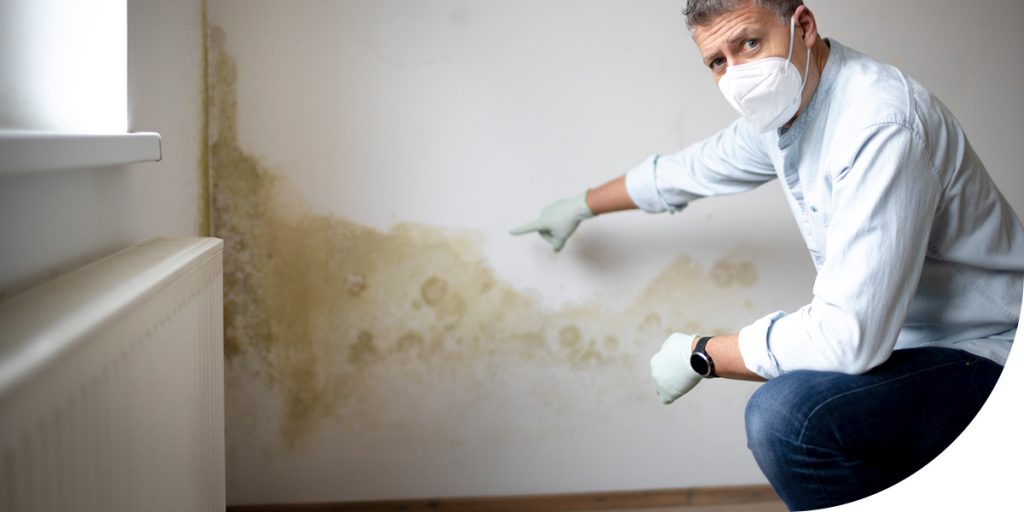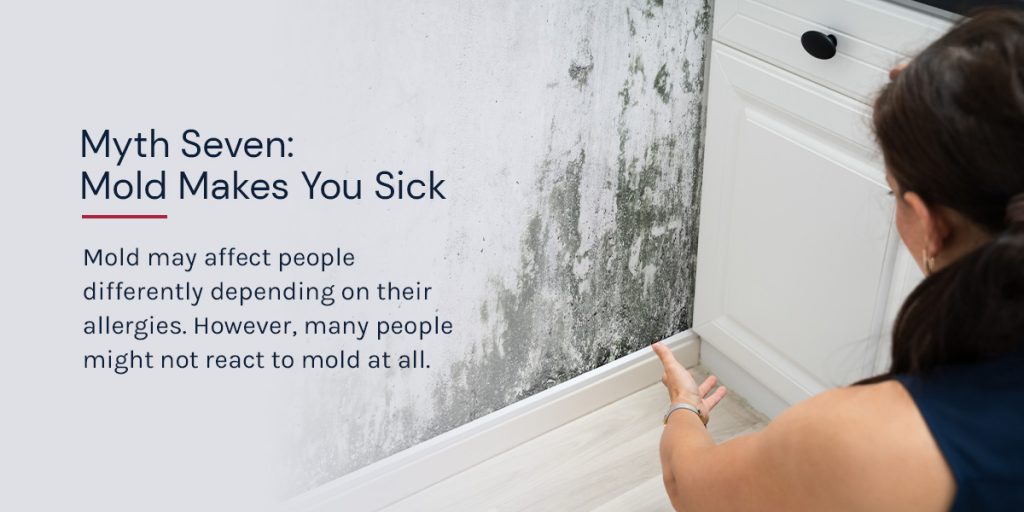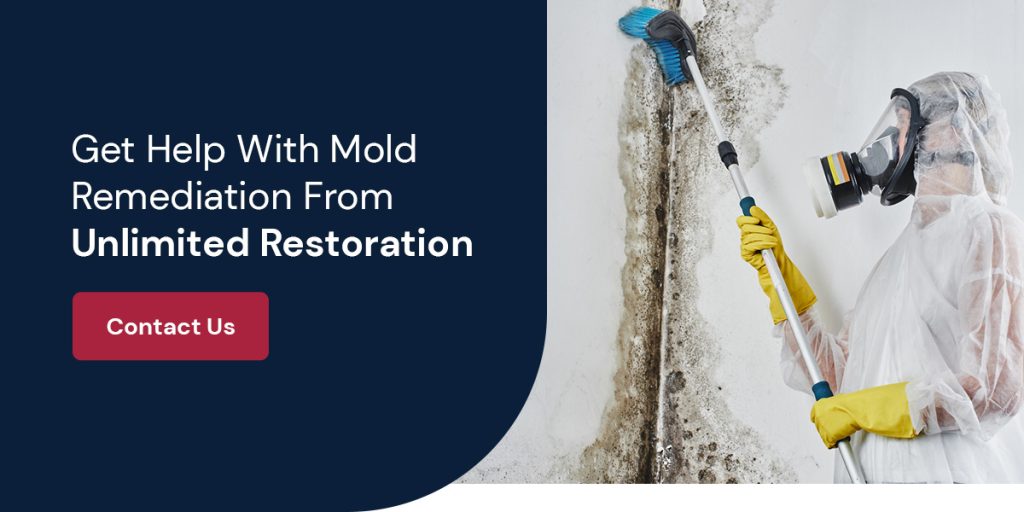
Many property owners or managers have concerns about finding mold on their properties. Mold misinformation is rampant due to some common myths passed down over the years. Here are ten mold myths and the truth behind them.
The most common mold myth says that you can use bleach to kill mold — however, this is not the case. While many kinds of mold require various cleaning methods and products, bleach will likely not work on porous surfaces. For the most part, the bleach will end up stripping the top layer of whatever you apply it to rather than eliminating the mold.
Using bleach to kill mold could also pose health risks to those on your property. Regulations from the Occupational Safety and Health Administration (OSHA) or the Environmental Protection Agency (EPA) recommend using other cleaning products and avoiding cleaning mold with bleach.
A great solution is to use dish detergent and water to clean the area. While this won’t kill the mold, it can create a safer environment until you can call a professional. A restoration company often has the right antimicrobial cleaners to kill the mold completely.
In most cases, cleaning mold by yourself is not a good idea. A professional repair and remediation company has the necessary tools and products to identify the cause of your mold, isolate the area and properly clean and eliminate mold from the site. Professionals also have the means to clean the air of harmful particles due to mold growth.
Cleaning the mold on your own will most likely not eliminate it, resulting in prolonged health issues. Professional equipment is needed to kill mold and handle moldy areas. Remediation companies also use protective equipment, HEPA vacuums, cleaning solutions and contamination and filtration units to dispose of mold growth properly.
While mold can be found in many places, not all types of mold are dangerous. Some mold variations are used for medicine or food products — for example, Penicillium mold is used to create the antibiotic penicillin, one of the most common antibiotics used today. Mold and fungus are also active ingredients in soft cheeses, like the white mold on Brie or the bluish-green mold in blue cheese.
This black mold myth is common. The fear of black mold probably comes from a kind of mold called Stachybotrys, a toxic mold that is dangerous to humans. But, while the existence of black mold may sometimes produce toxic substances, not all types of black mold produce toxic materials and substances.
Similarly, molds of different colors might also be dangerous to humans and animals, and for those allergic or sensitive to it, all molds can cause allergic reactions. If you find mold inside or outside your property, it’s best to have the growth analyzed and tested by a specialist to see if the mold is dangerous.
Keep in mind that a mold type’s toxicity is not related to its color. Many people think black mold is deadly when it is very rare to experience dangerous effects from it. In some conditions, black mold may produce mycotoxins, but it is hard to predict which mold types may have poisonous substances. Even if a kind of black mold is known to produce mycotoxins, it is not guaranteed that it always will, even if you find it on your property.
A small amount of mold will often lead to more significant issues if you don’t address it immediately. Mold can quickly spread to organic surfaces, and even small amounts can cause irritation for both human and animal inhabitants. You can also find mold on pipes, heating areas or ventilation systems. The more the mold grows, the easier it is to cause extreme damage to your property, resulting in costly repairs.

Mold may affect people differently depending on their allergies. If you are allergic to mold, you will likely experience symptoms like itchy eyes, runny nose, sneezing, coughing and difficulty breathing. However, many people might not react to mold at all. It is unlikely that mold will make you dangerously sick, although staying in a room with mold for a prolonged period can cause adverse effects on your health.
In many cases, a strange odor may indicate the existence of mold. Mildew, for example, thrives in humid areas of buildings like bathrooms and basements and often has a distinct, musty smell. However, just because there is no smell does not mean there is no mold on your property. You’ll want to hire a professional to find the mold and check common areas where moisture may accumulate.
Mold is not always visible. In some cases, you’ll notice musty odors where mold is growing, or you might see excess moisture in rooms, which is a breeding ground for mold. Contact a professional to test the area if you aren’t sure.
Mold spores can spread anywhere, meaning if you allow for an environment that promotes mold growth, you’ll find more mold again. Prevention techniques like dehumidifiers or moisture-resistant products are the best way to stop mold from spreading.
Now that you’ve learned the truth behind some common mold myths, you may be wondering about the dangers of mold or have questions about living and working in properties with mold. Here are some answers to common questions about mold.
It depends on the type of mold. For example, while sometimes dangerous, black mold does not always produce toxic substances. For the most part, various molds may cause people with allergies to experience runny noses or itchy eyes, but they won’t have dangerous effects on your health. Have a professional look at the mold in your commercial property to remove it and clarify what type of growth you’re experiencing.
While exposure to toxic molds is not good for you, it is unlikely that indoor mold will ever kill you. Prolonged exposure to molds may cause allergies or other health issues but will rarely result in death.
While it might not be dangerous to live in a house with mold, it certainly is not a good idea. Mold can cause other health issues that property owners should be aware of. You should remove the mold entirely as soon as you find or hear about mold on your property.

At Unlimited Restoration, our commercial and industrial property restoration professionals can help you repair damages from fire, storms or water. Whether you’re looking for emergency services or reliable repair and restoration services, we can locate mold spores within your home and predict possible damages and health hazards.
Our team is trained to spot the signs of mold, calling attention to the client’s need for mold remediation and containment. With over two decades of experience in mold remediation for commercial properties, our team members can take a look at your business and determine trouble areas for mold growth. Contact us today to speak to an Unlimited Restoration representative or call our 24/7 Emergency Response Hotline at 888-327-9664.